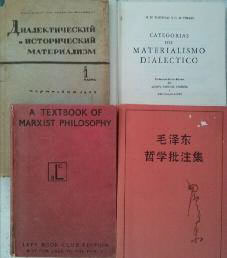
 |
FIGHT FOR COMMUNISM! |
International Communist Workers Party | |
“Without revolutionary theory there can be no revolutionary movement.” Lenin, What Is To Be Done

In our last column we described the Soviet textbooks that set up a new standard presentation of dialectics. This presentation was based on Engels’ three laws of dialectics and a list of opposite categories like actuality and possibility, appearance and essence, etc.
Soviet dialectics texts spread with the world communist movement and were translated into various languages. An English version of the Leningrad textbook appeared in 1937. Chinese students who studied in Japan used the Japanese and Russian versions to produce Chinese translations, which proved fundamental to the development of communist philosophy in China.
While the Soviet version of dialectics advanced the knowledge of dialectics world-wide, it also contained a fundamental error. This error was a philosophical version of the idea that socialism, with its wage system and inequality, leads to communism, and does so without a new revolution. This wrong idea is the so-called “non-antagonistic contradiction”
In his study of dialectics, Russian communist leader V. I. Lenin came to the profound conclusion that unity is not the main aspect of a contradiction: “The unity … of opposites is conditional, temporary, transitory, relative. The struggle of mutually exclusive opposites is absolute, just as development and motion are absolute.” This means that the struggle inside a contradiction does not tend to die out, but eventually becomes more intense and is resolved by the destruction of at least one side of it.
Socialist Dialectics
Beginning about 1930, Russian communists developed a different view of dialectics. They started to use the term “non-antagonistic contradiction” and its political counterpart, the concept of a “non-antagonistic class relationship.” This amounted to the claim that socialism doesn’t have the exploitation and class struggle that capitalism has. The Soviet textbooks defended the idea that the contradictions of socialism would gradually die out on their own or can be “managed” so that they don’t become intense and lead to rebellions and revolutions.
The actual history of the USSR and China showed that this picture is fundamentally wrong. In the USSR, the contradictions that existed between the working class and the peasants who sold them food led repeatedly to peasant resistance and sometimes to mass protests. In a grand compromise in the mid-’30s, peasants were organized into collective farms but allowed to keep their private plots and animals and sell their products. This private business constantly interfered with the operation of the collective economy.
More important than the peasant question was the growth of a new class of capitalists consisting of party leaders, factory managers and military officers. A series of internal struggles included large-scale arrests and executions in the ‘30s, and local rebellions by workers in the ‘50s. By the 1960s, workers’ political power in the USSR had been defeated and replaced by a wealthy “red” bourgeoisie that renounced revolution and advocated “peaceful coexistence” with imperialism, as it became an imperialist power itself.
No Contradictions are “Non-Antagonistic”
Scientific study of how contradictions are resolved, including the analysis of the evidence from class struggle, war, and natural science, etc., leads to the following conclusion:
Contradictions are only resolved or moved toward resolution by intensifying the struggle of their opposite sides, by increasing their negative relationship to each other, eventually destroying one (or both) sides. The way a contradiction is made more intense depends on the particular processes inside it.
The idea that the contradictions of socialism were “non-antagonistic,” that they could be safely ignored or “managed” out of existence was a disastrous myth. This myth disguised the capitalist nature of socialism and made it seem harmless to keep the wage system, rather than turning to communism.